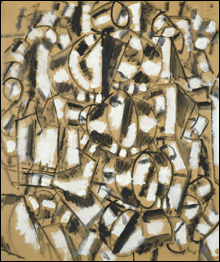
COMPOSITION (CONTRAST OF FORMS) (1912-’13): You can feel Léger tilting toward abstraction, as if racing to break the sound barrier. |
The Swiss artist John Armleder fancies himself a slippery shape shifter. “I have always been concerned about scrapping . . . the author factor from art,” he’s said. “I had this attitude that it would be more challenging for me to produce something that comes not from me but from the world.” And so “John M. Armleder: Too Much Is Not Enough,” billed as the first comprehensive US presentation of his work, fills the entire Rose Art Museum at Brandeis University with disco balls, mod furniture, knockoff Modernist paintings, and flashing neon lights. He is the ringmaster of this circus, an invisible man except for his always refined — if puckish — taste.
Born in 1948, Armleder was in his youth affiliated with the Fluxus conceptual-art jokers, and prone to stunts like painting a white gallery wall white and serving tea to visitors at the 1975 Paris Biennale. The Rose show opens with the Furniture Sculptures that outed him as a Post-Modernist in the 1980s. The idea was that at the end of Modernism, which exhausted its big main thrust somewhere around 1977, artists were free to riffle through the storehouse of art history and pop culture, shuffling and recycling the past, interrogating images and questioning ideas of originality and progress and high and low.
An untitled 1986 Furniture Sculpture features a white canvas dotted with four black rings and flanked by a pair of Modernist chrome-and-vinyl chairs clinging to the wall. In an untitled 2003 work, a designer space-age settee and floor lamps stand before a rainbow-striped canvas that recalls Ellsworth Kelly’s ’60s spectrum paintings. It’s like the perfect furniture-store display — and that’s the point. Armleder is admiring the beauty of these “found” sculptures. But it’s also a joke. And he’s saying that in the postmodernist marketplace of ideas, art is just another interchangeable accessory for interior decoration.
He makes this clear in Ne Dites Pas Non! (1996/2006), which, at the Rose, is a pair of mirror-image installations. He instructed Rose curator Raphaela Platow and a curatorial fellow to choose one example of each type of piece in the Rose’s permanent collection and add borrowed furniture. So an Alex Katz portrait of a woman mirrors a Gregory Gillespie self-portrait, a Mel Ramos reclining naked lady mirrors a Cindy Sherman self-portrait photo, and so on. Matched couches, lamps, and coffee tables complete the scenes. Armleder is amused by the surprises that result from giving up some artistic control: “I am a chance freak: paradise through randomness.”
Organized by Platow and Germany’s Kunstverein Hannover, “Too Much Is Not Enough” is a glittery sashay through ’60s and ’70s art — knockoffs of Kenneth Noland targets in Bruce Nauman neon, Morris Louis poured paintings, Larry Poons’s puddled paint canvases. Ten disco balls rotate above the museum’s indoor pond. Thirty mirrored domes hang on a gallery wall. There’s jumble of silvery fake Christmas trees jammed into a corner. The shiny spectacle is fun, but it grows tiresome, like someone who keeps telling you, through a forced smile, what a good time he’s having.